| Back to Back Issues Page |
 |
|
Restore Nature, Issue #014 July 14, 2024 |
HelloRESTORE NATURENewsletter 14July 2024I hope this finds you thriving. Down here we are in a situation which could be viewed many ways. Too much rain ?We've had excessively wet weather in the Cape. The rain pelts down with such a roar that it wakes us in the night. There seems to be a new pattern of heavy rain at night, with a little clearing up in the afternoon.The last two days many streets have been flooded and impassable in our relatively high lying neighbourhood. The butcher shop and surrounds were flooded by a raging river of storm water and I hate to think of the damage. On the level of minor inconvenience we've had power interruptions in our home due to short circuits in the power supply to the ponds and my husband has been in the roof placing and emptying buckets. The rest of Cape Town has been beaten hard. There are houses and churches inches deep in water. I don't know how one sleeps warm in such circumstances. I don't know how we are going to reduce our mismanagement and have a safer world for forthcoming generations. Its not just about carbon emissions, but in our management of water catchments that we need to wake up and change. Very often the flooding is due to the tiling over of vast areas in the built up suburbs with tar, concrete, roofs and paving. That is certainly the case in this suburb. Gardens with earth and plants are a rarity. There is nothing to absorb water when it comes down, and thus, when there is a very heavy fall, it leads to flooding. Excuse or opportunity ?I have not been able to get about and do the projects planned for this month's newsletter, as the bamboo build necessitated some work with concrete outside, and the other plans were for trips to famous local gardens. So I thought I would make this letter about the rain, and its effect on my garden, and see if there is anything to learn from it. Time for an iterative re-assessment of working with water ? There is no opportunity for that like excessive rainfall !Water, water everywhere !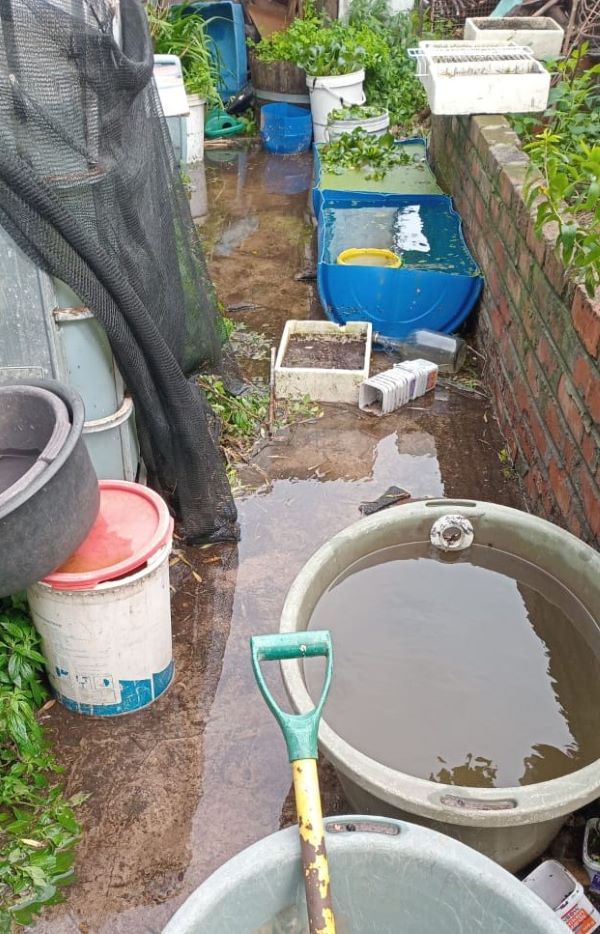 Certain areas around our home are flooded, like the whole of the drive-way work area and the garage. This points to improvements needed in the water management systems, like diversion of the water from the concrete driveway into the garden where it can be absorbed. This is easy enough to accomplish with some french drains and tiny cement ridges. I am sure that the two downpipes emptying in the driveway are a major cause of the flooding. It would be nice if this water could be stored more effectively.
Certain areas around our home are flooded, like the whole of the drive-way work area and the garage. This points to improvements needed in the water management systems, like diversion of the water from the concrete driveway into the garden where it can be absorbed. This is easy enough to accomplish with some french drains and tiny cement ridges. I am sure that the two downpipes emptying in the driveway are a major cause of the flooding. It would be nice if this water could be stored more effectively.
Good news is that the tanks we do have are all full. If I could find money for more water storage it would mean more independence from grid water and less flooding. 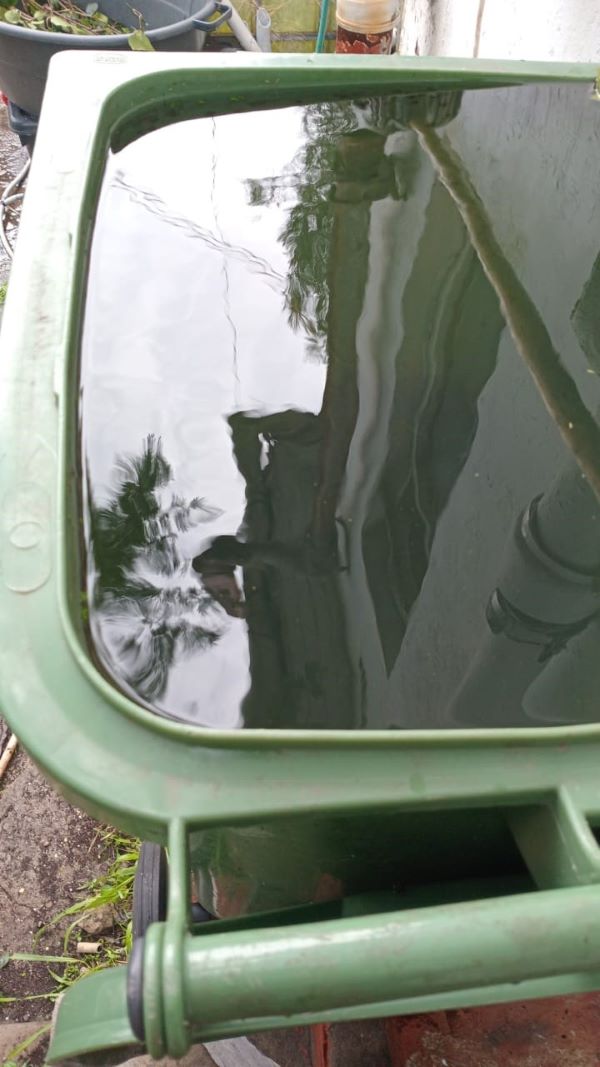 However, it would be easy to pipe tank overflow into the food forest where it would be welcome, and radically reduce the water arriving on the concrete via overflowing tanks. We do have an overflow system but its always blocked as the pipes are too small. I wish I'd known the importance of thinking about adequate pipe sizes when building. I could have avoided repeating the whole process of tank connecting and refitting pipe networks. But the garden is a school. This isn't a 'mistake' to be embarrassed about its part of the iterative process of natural design.
However, it would be easy to pipe tank overflow into the food forest where it would be welcome, and radically reduce the water arriving on the concrete via overflowing tanks. We do have an overflow system but its always blocked as the pipes are too small. I wish I'd known the importance of thinking about adequate pipe sizes when building. I could have avoided repeating the whole process of tank connecting and refitting pipe networks. But the garden is a school. This isn't a 'mistake' to be embarrassed about its part of the iterative process of natural design.
Just too wet for some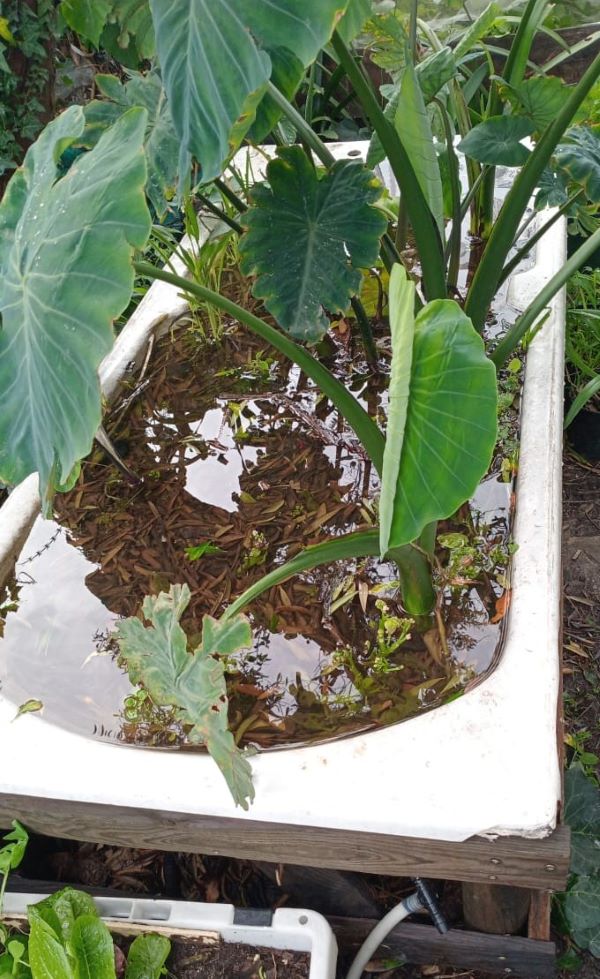 The wetland is also flooded. You can see how tiny the drain is, and that may be the reason. Nonetheless it is in such extreme conditions that you learn about your plants the hard way. The taro or amadumbe is not succumbing to the wet at all, though it does not thrive in the cold, it survives. It has not formed large tubers, and I noticed this months back, in summer, as there is not enough sun in this spot. The water chestnut (the sedge type) has long since rotted away. It seems it needs a dry period to mature, as the online growing instructions said.
The wetland is also flooded. You can see how tiny the drain is, and that may be the reason. Nonetheless it is in such extreme conditions that you learn about your plants the hard way. The taro or amadumbe is not succumbing to the wet at all, though it does not thrive in the cold, it survives. It has not formed large tubers, and I noticed this months back, in summer, as there is not enough sun in this spot. The water chestnut (the sedge type) has long since rotted away. It seems it needs a dry period to mature, as the online growing instructions said.
Most plants in my garden love rain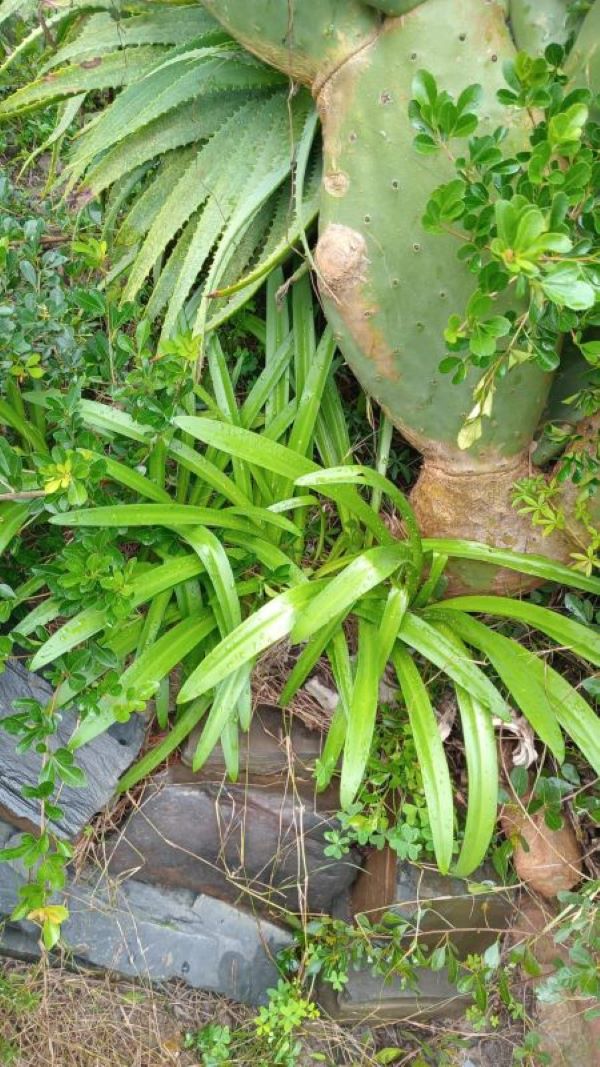 The plants in my garden have selected themselves for the Cape weather due to a combination of my ruthlessness and neglect. It isn't so surprising that all around the garden is a general greening, both with the plants that need the rain and those that according to gardening lore don't.
The plants in my garden have selected themselves for the Cape weather due to a combination of my ruthlessness and neglect. It isn't so surprising that all around the garden is a general greening, both with the plants that need the rain and those that according to gardening lore don't.
Among those that need the rain are the bulbs which push out green in the rainy season, such as Amaryllis belladonna. These have been in the family 3 generations, or about 50 years, multiplying and fattening up very slowly. Food plants thriving cold and wet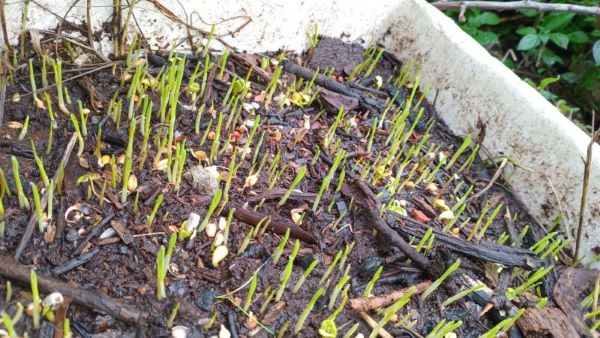 The food plants that are known to need rain are also looking good. The wheat and sorghum mix is sprouting. It is for feeding our canine friends, and they chewed the last lot of special canine micro greens to bits over a period of two months. I like to have the cereal sprouts around, or my little black terrier starts to eat random weeds in the garden and gets hives, which can be life threatening.
The food plants that are known to need rain are also looking good. The wheat and sorghum mix is sprouting. It is for feeding our canine friends, and they chewed the last lot of special canine micro greens to bits over a period of two months. I like to have the cereal sprouts around, or my little black terrier starts to eat random weeds in the garden and gets hives, which can be life threatening.
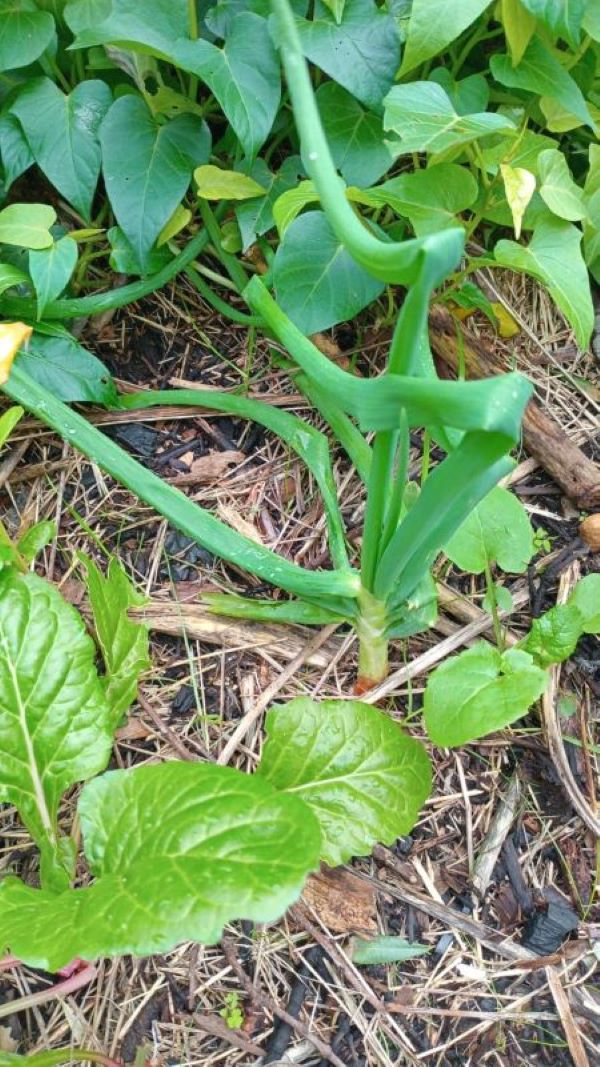 Another food plant which likes this weather is the onion. All our onions are thriving now. They are building the green tops they need instead of remaining stringy and small. You hear about bulbs rotting in damp weather. Its all a question of context. This place on the tip of the most beautiful continent of Africa can experience drought from October through to May, and the onions just die off without a lot of irrigation if planted too late and too close to the dry. We have torrential rain for a day or two and then a dry week, even in the current rainy season with its flooding.
Another food plant which likes this weather is the onion. All our onions are thriving now. They are building the green tops they need instead of remaining stringy and small. You hear about bulbs rotting in damp weather. Its all a question of context. This place on the tip of the most beautiful continent of Africa can experience drought from October through to May, and the onions just die off without a lot of irrigation if planted too late and too close to the dry. We have torrential rain for a day or two and then a dry week, even in the current rainy season with its flooding.
The areas which experience onion bulb rot must have rain almost daily for months on end. This is a great lesson to me in knowing my context and not accepting gardening lore from other areas of the world. As the best oleiriculturists will tell you, exact figures, not generalizations are the way to aquire skill in this complex art. Know the temperature, time to maturity, and the mm of water per m2 required rather than vague context dependent instructions like 'plant in spring when the weather warms up' or 'water well'. That kind of gardening lore is very very context dependent. Behind the onion you can see a plant that is static now, but not dying back, the red fleshed sweet potato. It was booming a month or two ago. I don't know if it is the cold or the wet that has slowed it down. We're having night time temperatures dip as low as 5 C some nights, though they are usually in the early teens.
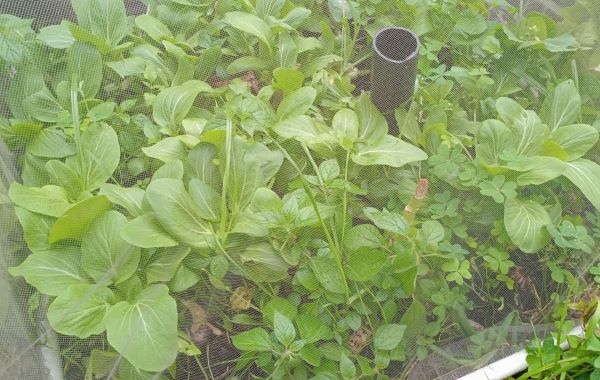 Next to the sweet potato, in the space it used to invade, the pak choi is doing just fine. I planted it really dense and net with tulle over pvc piping hoops. This is needed to allow us a harvest of cruciferae. I wonder how it is with snails and cabbage white in your neck of the woods ?
Next to the sweet potato, in the space it used to invade, the pak choi is doing just fine. I planted it really dense and net with tulle over pvc piping hoops. This is needed to allow us a harvest of cruciferae. I wonder how it is with snails and cabbage white in your neck of the woods ?
My 94 year old mum likes to harvest tender baby pak choi to eat with scrambled egg as all her food must be very soft. Her birthday was today. Here are the presents I wrapped for this one time botanist. The paper flowers are recycled from potato bags. Inside are nice warming items of clothing for the smaller peripheral areas of the body, namely fingers and toes. She knits her own caps and has enough of those. It seems we siblings showed good timing in the choice of presents.
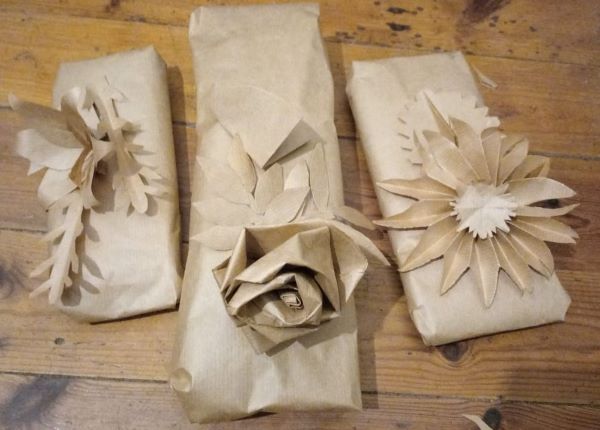
Some dry climate surprises !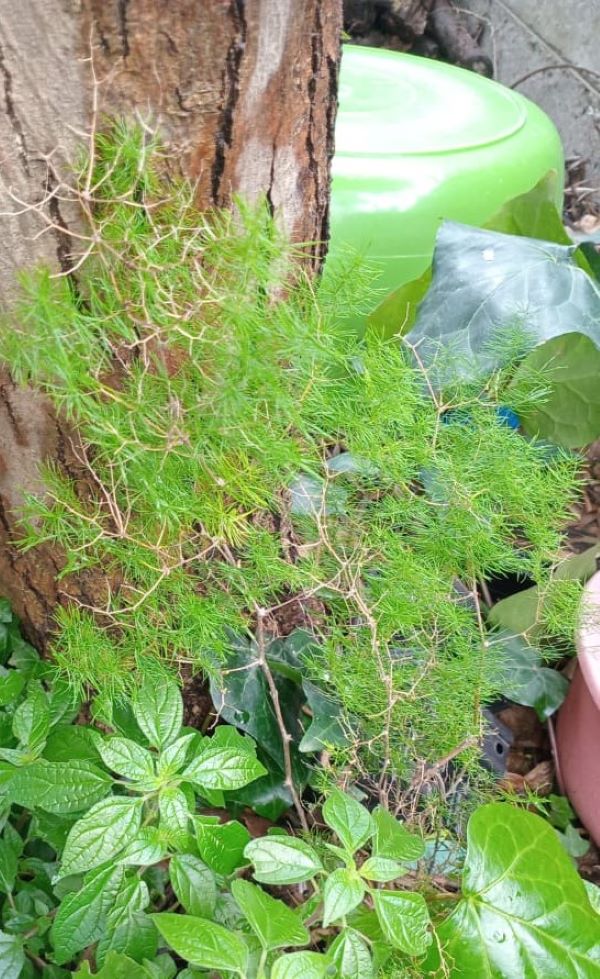 When the rains come there are plants you would think need no water, that surprise by greening up and branching out and clearly loving this sodden weather. A good example is the wild asparagus A. lignosis. I thought it had died, even though I watered it weekly in the dry of summer as the thirstier native plants should be watered. After being shriveled and brown for months it exploded into new growth with the rain.
When the rains come there are plants you would think need no water, that surprise by greening up and branching out and clearly loving this sodden weather. A good example is the wild asparagus A. lignosis. I thought it had died, even though I watered it weekly in the dry of summer as the thirstier native plants should be watered. After being shriveled and brown for months it exploded into new growth with the rain.
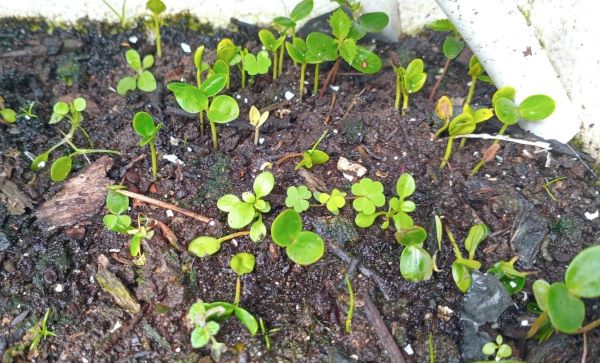 One of the hardiest trees I never water is the wild plum Carissa bispinosa. I find them difficult to grow from seed, but I had masses of seed from a recent fermentation for pink fruit vinegar. After sitting for weeks in a seed tray that any amount of irrigation had no effect on, up come these lovely shiny new seedlings with the rains. How do the seeds know ? They have incredible perception of their environment !
One of the hardiest trees I never water is the wild plum Carissa bispinosa. I find them difficult to grow from seed, but I had masses of seed from a recent fermentation for pink fruit vinegar. After sitting for weeks in a seed tray that any amount of irrigation had no effect on, up come these lovely shiny new seedlings with the rains. How do the seeds know ? They have incredible perception of their environment !
The biggest surprise of all is how the hardiest tree, another wild plum, the anti oxidant bomb Harpephyllum caffrum, the toughest of my saplings in the nursery, is putting forth gorgeous copper coloured new growth.
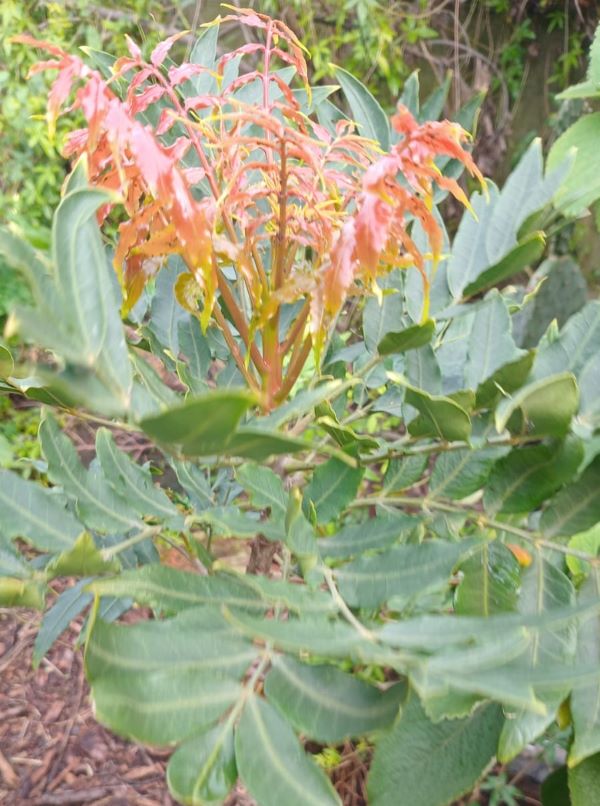
Lessons from adverse weather ?So all in all, this intense rain and cold is a teaching time. The things you expect to go under come up shining and the things you think can take it succumb. Its so important to do plant research that produces concrete plant data, and to keep a gardening diary so that exact figures in temperature and rainfall can guide you in the future. Some of the guess work must be taken out of the complexity of vegetable growing to make it manageable. This is especially important when our local conditions lie way outside those discussed in most gardening blogs. If we absorb their lessons without contextualizing it is really our own fault.I am keeping a diary now, and was convinced to do so by a gardening teacher who deals with many months of many degrees below zero, yearly. Now I'm looking for an organizing system for accessing all the information stored in the diary. In-document word searches do pretty well and get me to what I want about 90% of the time so I'm careful to be consistent with naming. Happy winter all southern gardeners, and happy summer all northern plant friends. The struggle continues, let's share what we've learned ! Topic suggestions welcomeYou may write to me anytime at the website greenidiom by filling out a comment. You can also use my webmail (website mail) address greenidi@greenidiom.com. Have you missed anything ?Please go to back issues right below if you want to catch up with what I've sent thus far as preamble for the course, as well as previous newsletters. |
| Back to Back Issues Page |